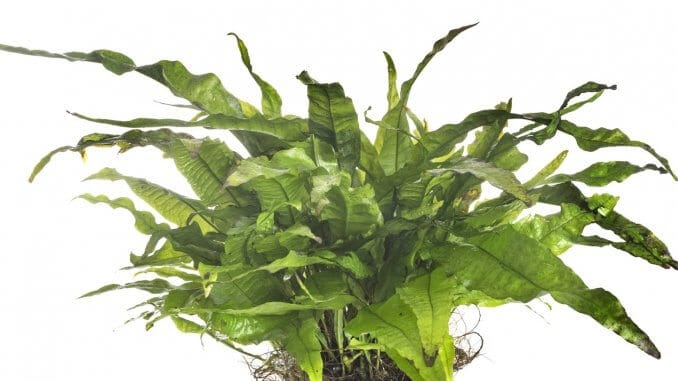
Java fern is a freshwater plant species that is used as a midground plant in aquariums. This green aquarium plant is a member of the Polypodiaceae family, which includes more than 60 different genera.
Java fern is green in color with a leathery texture and grows approximately 14 inches tall. The plant is popular with aquarists because it’s affordable and resilient.
TABLE OF CONTENTS
Java Fern Facts & Overview
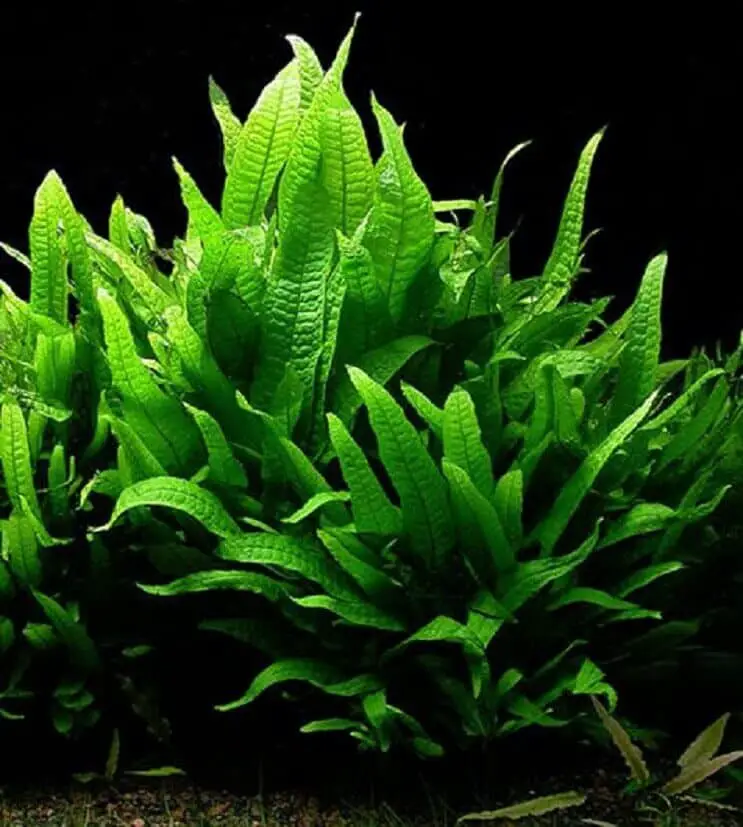
| Scientific name: | Microsorum pteropus |
| Common names: | Java fern |
| Origin: | Southeast Asia |
| Height: | 12–14 inches |
| Growth rate: | Slow (1 inch per month) |
| Color: | Green |
| Aquarium placement: | Midground |
| Water type: | Freshwater |
| Temperature: | 68–80°F (20–26°C) |
| pH: | 6.0–7.5 |
Distribution
The Java fern is native to the tropical jungles of Southeast Asia, where it grows on rocks and near waterfalls, and is often submerged partially or entirely underwater.
Availability
Java ferns are available at most pet stores that sell aquarium plants. They typically cost $4 to $9 depending on size.
You can buy this freshwater plant at AquariumCoop or AquariumFish.
Appearance & Size
The Java fern is a green, leafy plant made up of two main components — the rhizome and the leaves. A rhizome is a group of thin brown stalks that act as a stem for the fern by attaching themselves to surfaces.
This plant’s main attraction is its lush green leaves, which come in several shapes and colors. The leaves are long, slender, and can grow thickly, giving the fern a bushy appearance.
These plants grow slowly, at a rate of around one inch per month. When fully grown, you can expect your fern to reach a height of 13–14 inches. As it matures, its leaves sometimes develop dark brown bumps.
There are some rare types of Java fern that differ in appearance from the most common variant:
- Narrow-leaf Java fern — This variant has narrow leaves which grow at a steep angle. Narrow-leaf Java ferns typically grow to be 12 inches tall.
- Windelov Java fern — With a typical height of 8 inches, Windelov Java ferns are smaller than the common variant. The leaves of this variant split into three smaller leaves, creating a fork-like effect.
- Needle leaf Java fern — The needle leaf fern has even thinner leaves than the narrow leaf variety. This rare variant grows to be only 6 inches tall.
- Trident Java fern — This is one of the rarer variants with its unique feathery, lobed leaves. This variant is shorter than the narrow leaf fern, but it grows more quickly.
Benefits of Java Fern in Aquariums
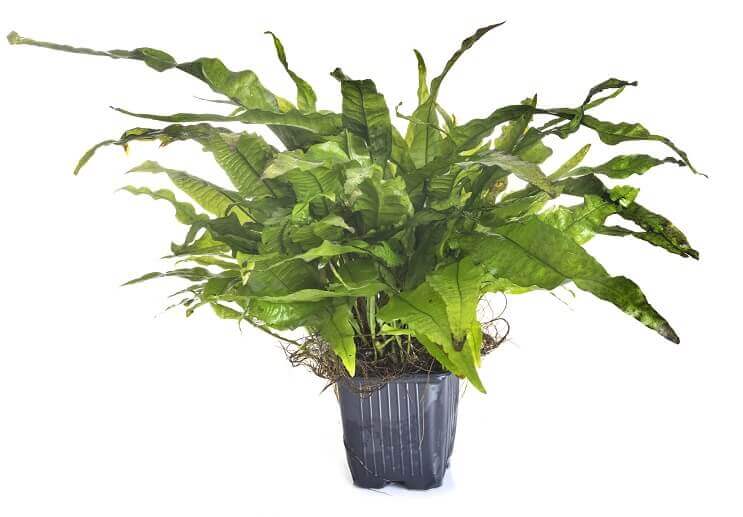
Java ferns absorb carbon dioxide from the water, making them a beneficial addition to any tank. This plant also requires minimal lighting, which reduces the likelihood of algae growing in the tank, and the plant’s leaves provide a great hiding place for small shy fish.
Compatible Tank Mates
Due to its robust nature, the Java fern is compatible with a huge variety of fish, including fish that are prone to damaging sensitive plants. If you plan to keep your fern in a tank with aggressive fish, plant it firmly on large rocks or driftwood to avoid accidental tipping.
Suitable tank mates for Java ferns include:
- Oscar fish
- Cichlids
- Tetras
- Freshwater snails
- Freshwater shrimp
They are compatible with most other freshwater plants, so adding one of these ferns to your aquarium doesn’t require much consideration.
Java Fern Tank Conditions & Requirements
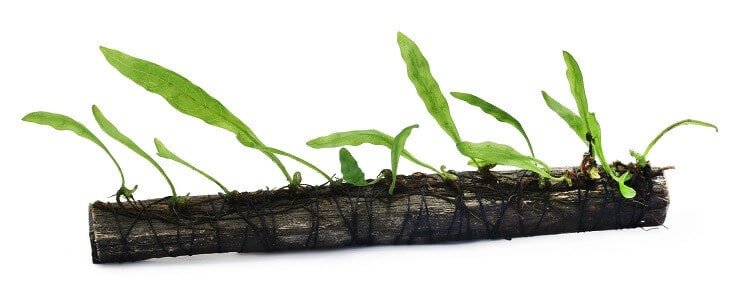
Java ferns are easy to care for because they have minimal requirements and are resilient in nature. In the wild, you’ll typically find them in shady areas, so the plants require similar low-lighting conditions in the tank.
They don’t require substrates such as gravel or sand, making them ideal for bare-bottom tanks. If you include substrate in the tank, don’t bury your fern in it, because doing so will rot the plant. Instead, grow your fern on a rock or piece of driftwood.
Tank Requirements
Java ferns are jungle plants, so they prefer tank conditions that mimic a similar shady, humid environment.
These plants thrive on the jungle floor where the water is soft and acidic, so keep the tank’s pH, temperature, and lighting similar to that of a damp and shady tropical forest. These freshwater plants will survive most conditions, but excess light can damage their leaves.
Tank Conditions
Java fern tank conditions should be as follows:
| Water type: | Freshwater |
| Tank size: | Minimum 10 gallons |
| Water temperature: | 68–80ºF |
| Required substrate: | None |
| Tank placement: | Midground or background |
| Acidity: | pH level 6.0–7.5 |
| Water hardness: | 3–8 dGH |
| Filter: | Any filters can be used with Java ferns |
| Light type & strength: | Subdued fluorescent |
| Hours of light: | Six hours per day |
While Java ferns are resilient and can grow in cold water, they prefer to be kept in a tank with warm water.
Tank Placement & Aquascaping
Java ferns decorate best in the mid-ground or background of the tank. Having a large fern at the front of your tank can obscure the view of fish or decorations.
These plants can grow to be bushy, so if you’re planting a few ferns in one tank, plant them far apart from each other.
How to Plant Java Fern in the Aquarium
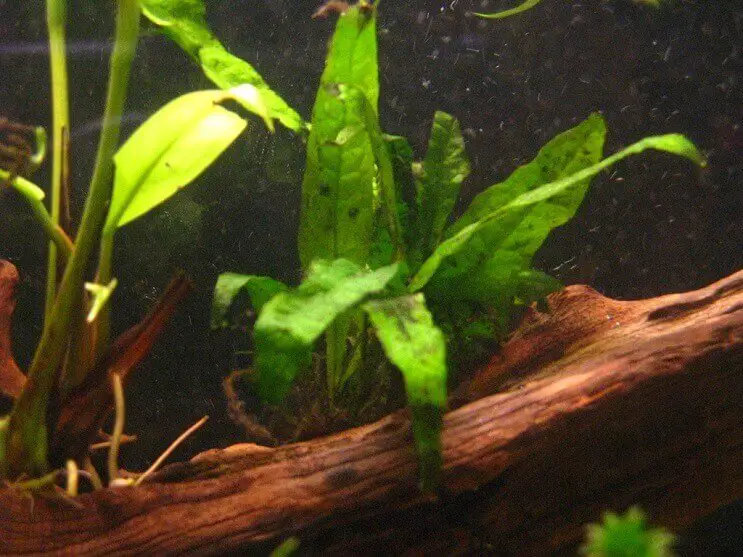
In order to safely introduce a Java fern to your aquarium, you must first quarantine the plant to ensure it is free of any pests and chemicals that could harm your fish.
Follow these steps to quarantine the plant:
- Remove any dead or dying leaves.
- Wear disposable gloves and mix one part unscented bleach with twenty parts water, then submerge your plant into the mix for up to 150 seconds.
- Rinse the plant thoroughly for a couple of minutes before introducing it to a quarantine tank.
- Your fern should stay in the quarantine tank for three to four weeks before being moved to the aquarium with other fish and plants.
To plant your Java fern in the main tank, put the plant near driftwood or rocks so it can attach itself to its preferred location. If you want to plant the fern on a particular rock or piece of wood, tie the plant there using a cable tie until it attaches itself.
Alternatively, simply place the fern in the tank and it will eventually find its own piece of wood or rock to attach to. Avoid burying the fern’s rhizome under sand or gravel because it will rot.
Java Fern Care & Growing Guide
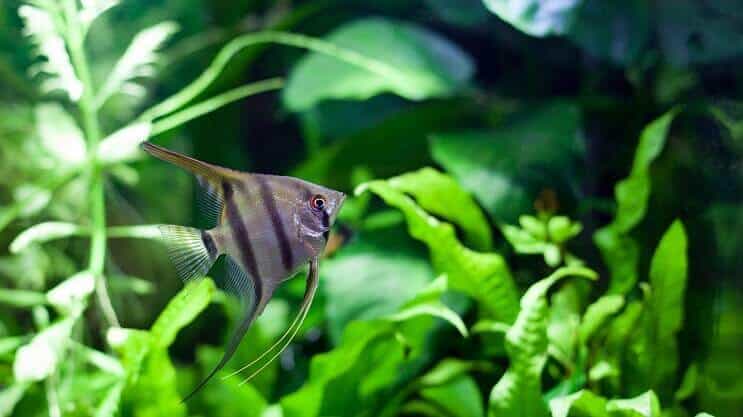
Java ferns’ hardy nature makes them easy to care for and virtually unkillable when kept in the right conditions.
Nutrition
The Java fern’s ability to draw nutrients from the water through its leaves means it doesn’t require fertilizer. However, if you want to encourage quicker growth, introduce a liquid fertilizer to the tank during water changes.
While CO2 isn’t necessary for Java fern growth, adding it to the tank will speed up the plant’s growth.
Maintenance
Avoid planting a Java fern in substrates such as gravel and rocks because doing so will rot the rhizome. You can tell if the rhizome is rotting when the Java fern turns brown.
Aquarists sometimes mistake black spots on the fern’s leaves as a disease when in fact, this is where the fern’s sprouts bud. However, if the black spots don’t grow new ferns after a few weeks, the black spots could indicate burns, so reduce the lighting level in the tank.
Java fern melt is another common problem that these plants face. Symptoms of melt include large brown spots that cause the fern to turn mushy. Melt typically occurs as a result of too much light or excessive algae in the tank. To treat melt, snip off the affected leaves and improve the tank lighting and algae conditions until the plant’s health improves. Fertilizer can help, too.
These plants don’t require regular pruning, but you can trim the fern occasionally if it grows too large for the tank.
To trim your fern, start by lowering the water level so you can reach the plant. Then remove any dead leaves using sharp scissors. You can then trim larger leaves and any small shoots to manage the fern’s growth.
How to Propagate Java Fern
Java fern propagation is relatively simple and doesn’t require special conditions.
Propagate your fern with one of the following two methods:
- Cut off a section of the rhizome with a few plants attached, and replant it. The separate plants will then grow if tied down to a spot in the tank
- Wait for the plant to develop tiny black spots on its leaves. These are tiny java ferns. Once they start to sprout, cut the tiny ferns off the leaves and plant them elsewhere in the tank
Should You Get a Java Fern for Your Aquarium?
Java ferns have minimal lighting and substrate requirements, so any budding fern owner simply needs a 10-gallon tank with a suitable water temperature.
This freshwater plant will remove carbon dioxide from the water and look attractive while doing so, making it the ideal addition to any aquarist’s tank.
If you’ve struggled to look after aquarium plants in the past, a Java fern could be the easy plant you’re looking for. Even plant veterans benefit from keeping this unique, colorful plant alongside other freshwater species.
Java Fern FAQs
- Can Java fern be planted in sand?
- Does Java fern absorb ammonia?
- How long can Java fern live without light?
- Why is my Java fern dying?
- Can you grow Java fern out of water?
- Why do Java ferns turn brown?
- How long does it take for Java fern to attach?
- Does Java fern reduce nitrates?
- How many hours of light does Java fern need?
- Will Java fern attach itself?
- Where should I put Java fern in my aquarium?
- Does Java fern need to be planted?

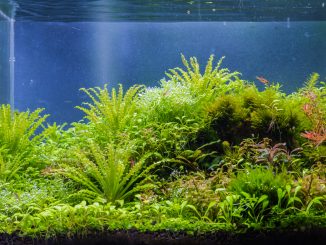
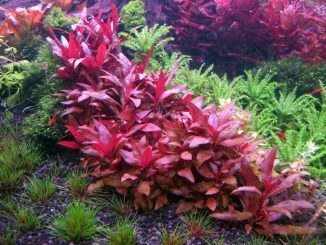
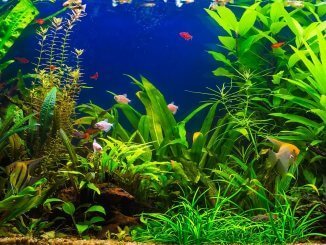
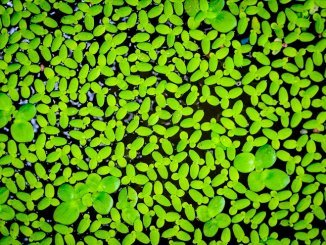
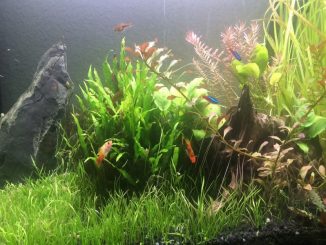
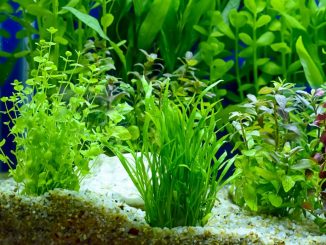
I frequently come on this site just to read through articles for the great advice and interesting information. Even species and plants I don’t keep are great to read up to and the articles dispense with all the padding I find on other sites that makes it difficult to find what I need to. You have quickly become my go to fish bible for concise, easy to absorb information on how to choose, keep and breed various species who with your help are all doing great things. Thank you for a great job done well.
Hi Emma, I’m so glad you enjoy the articles. Thanks for the great feedback, it makes doing what I do, even more worth while. Thanks, Robert
i enjoyed the articlle well written. I have some experience with Java Fern but need help. The plant grew well for about 6 months the plant grew to a nice size then one day i noticed some black spots than the leaves started to come apart. they looked like a house being built. all frame work with nothing inside. just like only the leaf veins left. can it be not enough fertilizer? The plant is in a 55 gallon tank i have an led light on it . I covered the light directly over it to reduce the light. nothing seems to help the rhyzome ie still green but not much else is left. I purchased another plant but it seems to be starting with the leaves turning black. The fish in the tank are guppies and they appear healthy.
Hi Ken, there are a few possible causes. The first, is that they might be getting too much light, how long is it left on for each day? Is there any algae in your tank? Algae will out compete your plants for nutrients. Black spots are usually a sign of nitrogen deficiency. If the veins are OK, but the actual leaf tissue is not, this suggests a calcium deficiency. Is there a chance that the water you’re adding to your tank is extra soft? If so, you’ll need to add Calcium Carbonate. Thanks, Robert
Hi there,
I was wondering how many ferns I would need to get for a 55 gallon aquarium? I want it moderately planted, there will be water wisteria too, but mostly java fern. How many would you recommend?
Hi Katie, it depends how planted you’d like the tank to be. You can include anywhere from 4 to 10. I currently have four in my 55 gallon setup. I have three attached to driftwood and another one attached to a stone. Thanks, Robert
Hello everyone! Thanks for the great article! Just read it through and found it super interesting! I just have one beginners doubt that I hope someone can give me a hand with. I attached a newly purchases fern to a piece of driftwood and, after a couple of days, I noticed that the rhizome turned brown and started to rot. I cut out the rotted part but was wondering if anyone might know why the rhizome got rot and what I can do if I see that it starts rotting again ( I will cut the whole plant if I just keep cutting everyone time it turns brown). Any advice? Thanks again!!
Hi Ines, this is pretty normal during the adjusting period for Java Fern, it can take around 6-8 weeks to fully adjust to new water conditions. Just keep removing any brown parts as you have done. Thanks, Robert
I’m after some advise please, I’m new to live plants and considering getting some Java fern for a 60 litre (roughly 13 gallon) Biorb fish tank that will be set up for tropical fish; most likely Tetra’s. I’ve read this is a good live plant to have in a Biorb as it doesn’t use substrate it has ceramic media instead. The lighting will be LED and on a built in timer setting.
The tank currently has no fish but has the previous water, for which I was planning on emptying the tank of water entirely, doing a 20-30% water change taking out the muckiest of the water than add the original ceramic media and refilling with a mix of the original water plus the fresh water.
If I went with the Java fern, how long after doing the above would I need to wait to add the Java Fern and then how long to wait to add fish or can the Java Fern and fish be added at the same time.
Apologies for the ramble, any help much appreciated.
Hi Kevin, thanks for your message. You can add the Java fern straight away, it will help with cycling the tank. You’ll need to wait 4-6 weeks to add any fish. You can buy a water testing kit to help you monitor the water. The ammonia and nitrites will need to spike and drop to zero before you add any fish. Many thanks, Robert
I have had Java Plant in a large 4ft long by 18 inches deep tank for 10 years and various other plants that fish eat off and die.
Java fern appears to die each year as leaves go black and appear black and hairy, then it suddenly re-grows without treatment. I was burying the young sprouts that break off and float, which I planted into the gravel and then after reading items on this sight realize that is a problem.
I have now attached some Java fern to terracotta pots and some driftwood and each year the same thing happens.
Recently I had to do an emergency full empty of tank to move it to enable repair to house and floor after a cyclone, so I shifted fish and Java plant that was left into a very small tank and took all stones and gravel out and put stones in sun for weeks to kill any elegy.
To assist with air flow for 6 fantail fish left I only had 2 air stones and a small fountain immersible pump in emergency tank and the fern is thriving and the fish have grown.
I added Java fern to a terracotta ornamental pot recently with a hole straight thru and it appears to be growing new leaves and roots.
I only have 5 fantail fish left that are around 7cm to 9 cm long from old tank.
I wish to put a lot more plants in the replaced large tank and advise is appreciated on which plants to use plus which fish to add with medium size fantails as the children love them.
I have and wish low maintenance fish and plants that are very compatible.
We are on a farm in a very drought area of Australia and have very little rain water sadly I am forced to use bore water which is a bit salty, at time to shandy it with some rain water for 3rd water changes.
As stated the water change is not desirable and is not done as often as it should be however the grandchildren love the tank and love to feed the fish which all have names and that have adapted to ours and their circumstances
Java plant appears to tolerate the sometimes salty water and so does current fish, I did have a banana Lilly that lived for many years but died when I had to sift the tank, other plants die mainly as the fish appear to attack them so nothing is left although they are fed regularly each day.
Once I add new pants and water, when can I add existing fish and new fish to the large tank.
Hi Ann, as a planted tank owner and a fantail owner I would recommend not putting plants in with them. They will keep being eaten, unless they are tough water lily’s or rushes. I have found a bit of work around where I have a sump above the water tank (which is my pond). That is where I grow rushes, lucky bamboo and some other semi aquatic plants in, such as java fern. I also have a floating island I made that also has moss and other aquatic plants growing on it, including some herbs. I have found by doing this, the plants still remove the nitrates from the water, but the fantails can’t reach them to eat them. If you have a hang on the back filter you can plant pothos, lucky bamboo and peace lily’s in it and it would do the same thing. You can also create an island out of styrofoam and use some fine scoria or those clay hydroponic balls as a planting media. You make a ring shape with the styrofoam and pop in a pot in the middle. You can cover the styrofoam with some coco fiber matting or chop up some coco fiber and paint on some 100% black silicon and press it in firmly for a more natural look. You can also get sand coloured silicon and press in sand instead. Let it cure for at least 24 hours, pop a pot with drainage holes in the middle pop a heavy rock in the middle to weigh it down if the pot pops out and put in either fine scoria or hydroponic clay balls, then your plants. Also at Bunnings you can buy already planted floating pots for ponds as well. Unfortunately, I have never found a plant that I can put in with them that they wont eat and even when they were inside in a big tank. Bunnings also sells rushes and other semi aquatic plants you can use. I hardly ever do water changes on their 1 ton pond because of their plants in their sump and on their island because the nitrates stay relatively low. Hope that was some help, as I saw no one replied to you because I guess they didn’t want to give you the bad news about not being able to keep plants inside their tank.
I love planted tank but i am afraid to use these aquatic plants coz of my oscar fish. He dig substrate & reallocate things sometimes. I worry what he will do with these beautiful plants?. But thanks for valuable info.
Hi Vivek, Hornwort is a good choice to keep with Oscar fish. You can read more about keeping them here: https://www.fishkeepingworld.com/oscar-fish/ Thanks, Robert
Hi,
I am just getting started with a planted aquarium.
I have two large goldfish in a 50 gallon tank.
To provide enough oxygen for the fish, I run a Tetra Whisper filter, an Eheim cannister filter, and have two airstones. I also have a heater.
I have tried growing Java fern.
They start out fine, but soon get BLACK SPOTS, then the ENTIRE SURFACE OF THE LEAVES TURN BLACK.
They soon die.
I anchored them and did not bury their rhizomes.
I tried both Flourish and NilocG fertilizers. No joy.
I bought an additional 20 watt aquarium bulb to supplement my LED fixture. No joy.
I read that Java fern turning black can be caused by iron deficiency. Added supplemental iron. No joy.
I read that Java fern turning black can be caused by nitrogen deficiency.
But when I test for nitrates I always have *plenty*.
I read that aquatic plants like *low* turbulence, is my aquarium too turbulent, and removing CO2?
Should I try a different plant? I tried Amazon Sword but it died very quickly.
Should I try adding nitrogen?
Any tips or advice appreciated!
Mark
Hi Mark, It’s hard to diagnose the exact problem without running some trials, but it might be that the plant is stressed in a new environment. Before trying additives, always work to find a solution that is naturally supported by the ecosystem you are creating. Remove any dead leaves as soon as they go brown, they should pull off quite easily. Make sure that your Fern gets plenty of light, but not for more than 10 hours a day. The plant will be using it’s nutrients to repair the dead leaves instead of for rooting. It took about 6 weeks for the plant to look like it was surviving well, don’t worry if the only leaves you are left with are small ones. Let us know how it goes. Thanks, Robert
Got a small java fern and attached to a rock using glue.
The fern has spread across rock really well and New seedlings have started to spread round my tank.
Hi,
Thanks for the complete knowledge provided but I wanted to know if I introduced it in my fresh water aquarium and my one small tiger fish died because of less oxygen.
My name is Prasad
I am new to aquarium hobby.I had a question about trees if introduced in tank will fish die ??
I have 2 tiger barbs(one small and one big) and one rosy
I brought Java fern on Sunday night and introduced it in my tank then on Monday small tiger barb started gasping for air.It could be because I have a sponge filter with slow bubbles.Then when I googled it I found that if light is less then plant takes oxygen from aquarium and gives CO2.Then on Monday night I removed the plant and kept fish as is.Today morning my Fish died ?I am not able to understand the reason behind it.Is it because of Java fern introduced in tank?
How does Java Fern do with Discus fish?
I’ve got a cycled tank that has been setup for just over a month. 5 gallon, Betta, mystery snail, a Narrow leaf, and a Windelov. The Narrow leaf has developed growths on it, and I was wondering if it was ok. Glad to see it’s just reproducing.